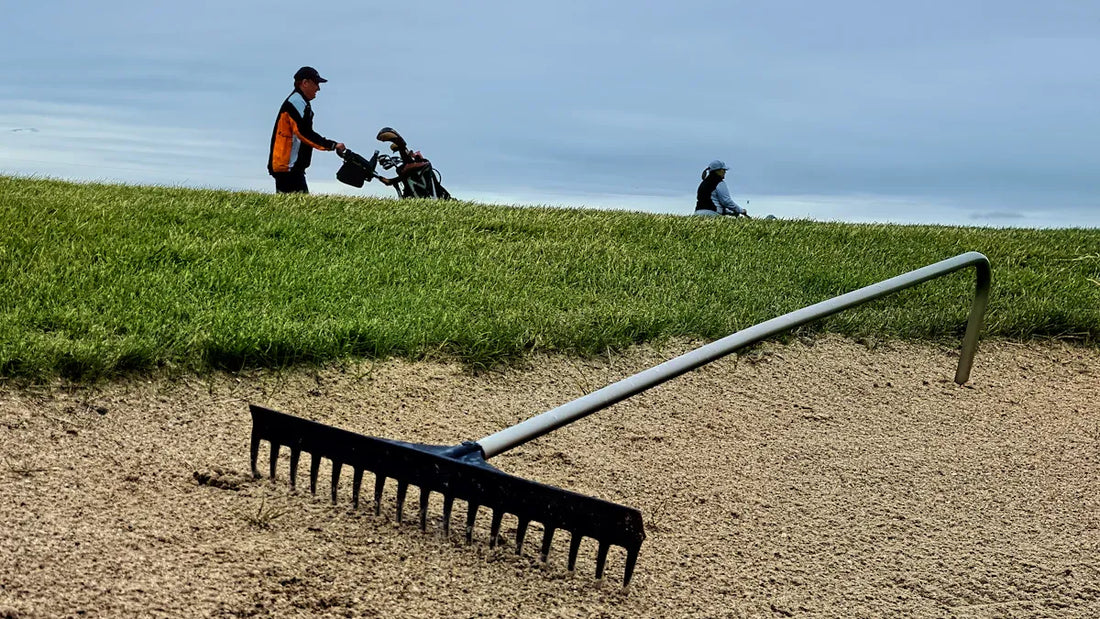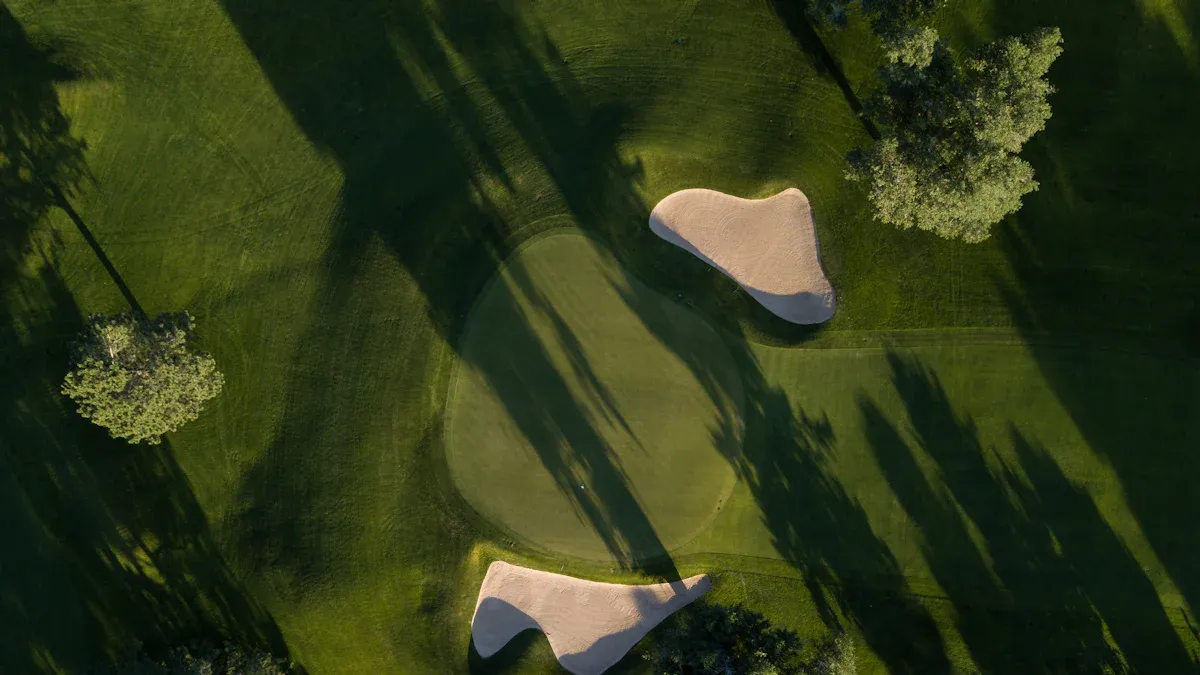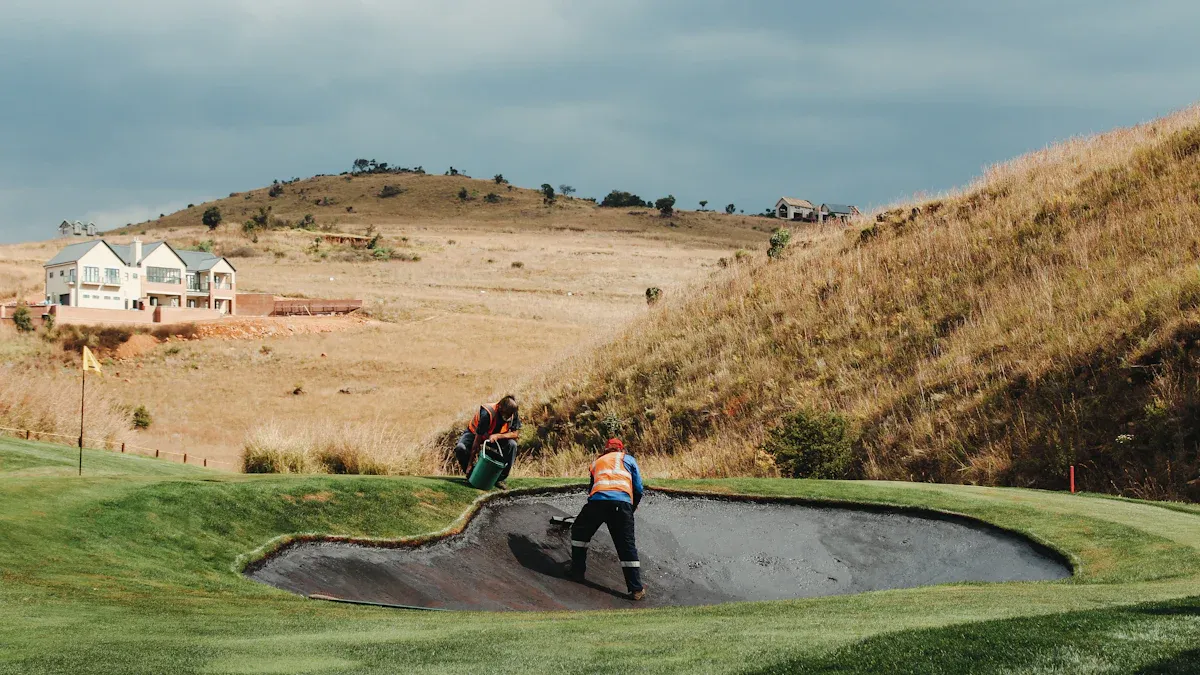
The Ultimate Guide to Golf Bunker Maintenance
Share
Golf bunker maintenance plays a critical role in keeping the course playable and visually appealing. Without proper care, bunkers can quickly lose their functionality and charm. For example, a course with 4 acres of bunkers once required 3,000 tons of sand, costing $150,000 for renovation. By reducing the bunker area to 2 acres, the course saved $75,000 on sand alone. This highlights how strategic maintenance not only improves aesthetics but also ensures cost efficiency. When you prioritize consistent upkeep, you create a better experience for players while extending the life of your bunkers.
Teego AI Golf Tee Time Bot
The only 24/7 automated tee time booking system that directly integrates with GolfNow, guaranteeing zero missed bookings.
Get A Quote NowKey Takeaways
- Use good-quality silica sand with the right size for better play and lasting use.
- Keep sand 4-6 inches deep in most bunkers to avoid hard spots and keep it even.
- Rake the sand often to keep it soft, look nice, and make playing easier.
- Make sure drains work well to stop water from sitting, which can ruin the sand.
- Check and fix bunker edges often to stop plants from growing over and keep the course looking neat.
Sand Quality and Depth

Importance of Sand Quality
Characteristics of Ideal Bunker Sand
The quality of sand in a bunker directly affects its performance and longevity. Ideal bunker sand should have specific characteristics to ensure optimal playability and ease of maintenance:
- Particle Size Distribution: Sand particles should range between 0.25 to 1.0 mm. This size ensures proper firmness and drainage.
- Sand Mineralogy: Silica sand is the preferred choice due to its durability and resistance to weathering. Limestone sand, on the other hand, can cause drainage problems.
- Shape of Particles: Angular particles provide better surface strength and resist erosion compared to rounded ones.
| Evidence Type | Description |
|---|---|
| Particle Size | Ensures firmness and proper drainage. |
| Sand Mineralogy | Silica sand resists weathering; limestone sand may lead to drainage issues. |
| Impact of Shape | Angular sands resist erosion better than rounded sands. |
| Maintenance Needs | Regular testing and replenishment prevent contamination and compaction. |
Impact of Sand Quality on Playability and Aesthetics
High-quality sand enhances the playability of your bunkers. Proper particle size and shape influence how the sand interacts with the club and ball, affecting shot outcomes. For example, firm sand allows low-handicapped players to generate spin, while softer sand benefits higher-handicapped players. Additionally, sand color impacts the visual appeal of your course. Bright, clean sand creates a polished look, but it can also cause glare under direct sunlight. Regular sand testing and replenishment ensure consistent conditions, preventing contamination and compaction over time.
Maintaining Proper Sand Depth
Recommended Sand Depth for Optimal Performance
Maintaining the correct sand depth is crucial for bunker performance. Experts recommend a depth of 4-6 inches for most bunkers. However, firmer sands may require a depth of 8-10 inches, depending on the bunker design. Testing methods, such as the SMRC or moisture column test, help determine the ideal depth. These tests ensure the sand retains about 15% moisture content one inch below the surface after 24-48 hours of drying.
| Recommendation | Details |
|---|---|
| Ideal Sand Depth | 4-6 inches for most bunkers; 8-10 inches for firmer sands. |
| Testing Standards | SMRC or moisture column test ensures 15% moisture content. |
Tips for Monitoring and Replenishing Sand Levels
Regular monitoring prevents uneven surfaces and ensures consistent playability. You can use a depth gauge to measure sand levels across the bunker. Replenish sand when levels drop below the recommended depth. Always spread new sand evenly and compact it lightly to maintain uniformity. Frequent inspections help identify areas prone to sand displacement, allowing you to address issues before they affect playability.
Tip: Incorporate routine sand testing into your golf bunker maintenance schedule. This ensures your bunkers remain consistent and playable throughout the year.
Routine Raking Practices
Benefits of Regular Raking
Preventing Compaction and Maintaining Smooth Surfaces
Frequent raking is essential for keeping bunker sand loose and preventing compaction. Compacted sand creates hard surfaces that negatively impact gameplay. Loose sand, on the other hand, allows players to execute consistent shots. Regular raking also smooths out uneven areas caused by golfer activity or weather, ensuring a uniform surface.
Routine maintenance, including the use of long tines on a mechanical rake to loosen existing sand, is essential. This approach is most effective when performed regularly, as one-time procedures are insufficient for maintaining bunker quality.
Enhancing Bunker Aesthetics Through Consistent Raking
A well-raked bunker significantly improves the visual appeal of your golf course. Smooth, clean sand creates a polished look that enhances the overall aesthetics. Regular raking also removes debris, such as leaves or twigs, keeping the sand clean and free from contamination. This attention to detail ensures that your bunkers remain a highlight of the course.
-
Key Benefits of Regular Raking:
- Prevents compaction and maintains loose sand.
- Enhances the overall appearance of the golf course.
- Removes debris, reducing contamination.
- Improves drainage by preventing water retention.
- Ensures consistent playability across all bunkers.
Best Raking Techniques
Manual vs. Mechanical Raking: Advantages and Disadvantages
You can choose between manual and mechanical raking based on your course's needs. Manual raking allows for precise control, making it ideal for smaller bunkers or areas with intricate designs. However, it requires more time and effort. Mechanical raking, on the other hand, is faster and more efficient for larger bunkers. It also loosens compacted sand more effectively. The downside is that mechanical rakes may struggle with tight corners or delicate edges.
| Raking Method | Advantages | Disadvantages |
|---|---|---|
| Manual Raking | Precise control, ideal for details | Time-consuming, labor-intensive |
| Mechanical Raking | Fast, efficient for large bunkers | Less effective in tight spaces |
Achieving Uniform Raking Patterns for Better Playability
Uniform raking patterns are crucial for maintaining consistent playability. Start by raking from the edges toward the center of the bunker. This technique prevents sand from being displaced outward. Use overlapping strokes to ensure no areas are missed. For mechanical raking, adjust the settings to create even grooves without digging too deep. Consistency in your raking patterns ensures that players experience the same conditions across all bunkers.
Tip: Train your maintenance team to follow a standardized raking routine. This ensures uniformity and reduces the risk of uneven surfaces.
Managing Bunker Edges

Trimming and Shaping
Tools and Techniques for Clean and Defined Edges
Maintaining clean and defined bunker edges is essential for both aesthetics and functionality. You can achieve this by using tools like edging shears, spades, and string trimmers. These tools allow you to create crisp, vertical edges that prevent overgrowth and keep the sand contained within the bunker. Regular trimming ensures that turf does not encroach into the sand, which can lead to contamination and uneven surfaces.
| Key Consideration | Description |
|---|---|
| Edge Maintenance | Maintaining a crisp vertical edge requires significant labor but enhances aesthetics and functionality. |
| Soil Contamination | Exposed soil edges can contaminate sand; proper maintenance prevents this. |
| Architectural Changes | Modifying edges to cover soil can reduce contamination and improve bunker integrity. |
How Edge Maintenance Improves Bunker Aesthetics
Well-maintained bunker edges significantly enhance the visual appeal of your golf course. Defined edges create a polished look, making the bunkers stand out against the surrounding turf. Regular trimming also prevents overgrowth, ensuring the sand remains within its designated area. This attention to detail not only improves aesthetics but also reduces sand erosion and contamination.
- Benefits of trimming and shaping bunker edges:
- Enhances course appearance and prevents sand erosion.
- Maintains clarity and precision by keeping sand clean.
- Minimizes soil contamination through architectural changes like wrapping sod over edges.
Stabilizing Bunker Edges
Preventing Edge Collapse with Proper Reinforcement
Edge collapse can compromise the integrity of your bunkers. To prevent this, you should focus on maintaining a stable turf edge. Growing turf into the bunker sand and maintaining it there helps reinforce the edges, reducing the risk of collapse. This method also prevents deep edging into native soil, which can lead to instability. Regular monitoring ensures that the edges remain intact and free from contamination, preserving the quality of the sand.
Using Vegetation or Liners for Added Stability
Vegetation and liners provide additional stability to bunker edges. Planting grass or other vegetation around the edges helps anchor the soil, reducing the risk of erosion. Liners, such as geotextiles, act as a barrier between the sand and the soil, preventing contamination and maintaining the bunker’s structure. These methods not only stabilize the edges but also extend the lifespan of your bunkers, making them easier to maintain in the long run.
Tip: Combine vegetation and liners for maximum edge stability. This dual approach ensures long-lasting reinforcement and reduces maintenance efforts.
Enhancing Drainage Systems
Importance of Proper Drainage
How drainage impacts sand longevity and playability
Proper drainage is essential for maintaining the quality and functionality of your bunkers. Without it, water can pool in the sand, leading to compaction and contamination. Poor drainage also shortens the lifespan of the sand, as standing water accelerates erosion and promotes the growth of algae or moss. When drainage works effectively, it keeps the sand dry and firm, ensuring consistent playability for golfers. You’ll notice that well-drained bunkers allow players to execute clean shots without the frustration of wet or compacted sand.
Common drainage issues and their effects on bunkers
Several common problems can disrupt bunker drainage. Blocked drainage pipes, caused by debris or sand buildup, prevent water from flowing out. Improperly installed systems may fail to direct water away from the bunker, leading to pooling. Additionally, heavy rainfall can overwhelm outdated systems, leaving the sand waterlogged. These issues not only affect playability but also increase maintenance costs. Addressing drainage problems promptly helps you avoid long-term damage to your bunkers.
Improving Bunker Drainage
Installing or upgrading drainage systems
Installing a high-quality drainage system is one of the best ways to improve bunker performance. Start by assessing the current drainage setup. If it’s outdated or ineffective, consider upgrading to modern systems like perforated pipes or gravel trenches. These systems channel water away from the bunker, keeping the sand dry and playable. When installing new drainage, ensure the slope of the bunker directs water toward the drainage points. This design prevents water from pooling in low areas.
Regular maintenance to prevent clogging and water pooling
Routine maintenance keeps your drainage system functioning properly. Inspect the pipes and trenches regularly for clogs caused by sand or debris. Use tools like drain snakes or high-pressure water jets to clear blockages. After heavy rainfall, check for signs of water pooling and address any issues immediately. Consistent upkeep ensures your bunkers remain in top condition, reducing the need for costly repairs.
Tip: Combine regular inspections with preventive measures, such as installing filters over drainage inlets, to minimize blockages and extend the life of your system.
Erosion and Sand Displacement Control
Causes of Erosion in Bunkers
Weather-related factors and golfer activity
Erosion in bunkers often stems from natural forces and player activity. Heavy rainfall washes sand down slopes, creating uneven surfaces and exposing the bunker base. Strong winds displace sand, especially in open areas, leaving some spots bare. Golfer activity also contributes to erosion. Players stepping in and out of bunkers disturb the sand, causing it to shift and compact over time. These factors reduce the bunker’s playability and increase maintenance demands.
Tip: Monitor bunkers after storms or periods of high player traffic to identify erosion-prone areas early.
Poor design and its role in exacerbating erosion
Bunker design plays a significant role in erosion control. Poorly designed bunkers with steep slopes or inadequate drainage systems are more prone to sand displacement. Water flows faster down steep slopes, carrying sand with it. Similarly, bunkers without proper drainage retain water, leading to compaction and further erosion. Addressing design flaws helps minimize these issues and reduces the frequency of repairs.
Solutions for Erosion Control
Installing bunker liners to reduce sand displacement
Bunker liners provide an effective solution for controlling erosion. These liners act as a barrier between the sand and the soil, preventing sand from washing away during heavy rain. They also improve drainage by allowing water to pass through while keeping the sand in place. Installing liners reduces the need for frequent sand replenishment, saving time and resources. Choose durable materials like geotextiles or rubber liners for long-lasting results.
Using vegetation or barriers to minimize erosion
Vegetation and barriers offer additional protection against erosion. Planting grass or shrubs around bunker edges stabilizes the soil and prevents sand from being displaced by wind or water. Barriers, such as wooden planks or stone walls, act as physical shields, reducing the impact of external forces. Combining these methods with proper maintenance ensures your bunkers remain stable and visually appealing.
Note: Regularly inspect vegetation and barriers to ensure they remain effective in controlling erosion.
Maintaining your bunkers is essential for a high-quality golf course. Focus on key strategies like ensuring proper sand quality, regular raking, and precise edge management. Enhance drainage systems and control erosion to keep your bunkers functional and visually appealing. Consistent golf bunker maintenance not only improves playability but also extends the life of your course features. By implementing these practices, you create a better experience for players and reduce long-term costs. Start prioritizing these steps today to achieve lasting success.
FAQ
What is the best way to test sand quality in bunkers?
You can test sand quality by analyzing particle size, shape, and mineral composition. Use a sieve analysis to measure particle size distribution. Check for angular particles and silica content for durability. Regular testing ensures the sand meets playability and drainage standards.
How often should you rake bunkers?
Rake bunkers daily or after heavy use to maintain smooth surfaces and prevent compaction. For courses with high traffic, consider raking multiple times a day. Regular raking keeps the sand loose and ensures consistent playability for golfers.
What tools are essential for maintaining bunker edges?
Use edging shears, spades, and string trimmers to maintain clean and defined edges. These tools help you trim overgrowth and prevent turf from encroaching into the sand. Regular edge maintenance improves both aesthetics and functionality.
How can you prevent water pooling in bunkers?
Install a proper drainage system with perforated pipes or gravel trenches. Regularly inspect and clean the drainage system to prevent clogs. Ensure the bunker design slopes toward drainage points to direct water away efficiently.
What are the benefits of using bunker liners?
Bunker liners reduce sand displacement and improve drainage. They act as a barrier between the sand and soil, preventing contamination. Liners also minimize erosion, saving you time and resources on frequent sand replenishment.
Tip: Combine liners with vegetation around edges for maximum stability and longevity.
